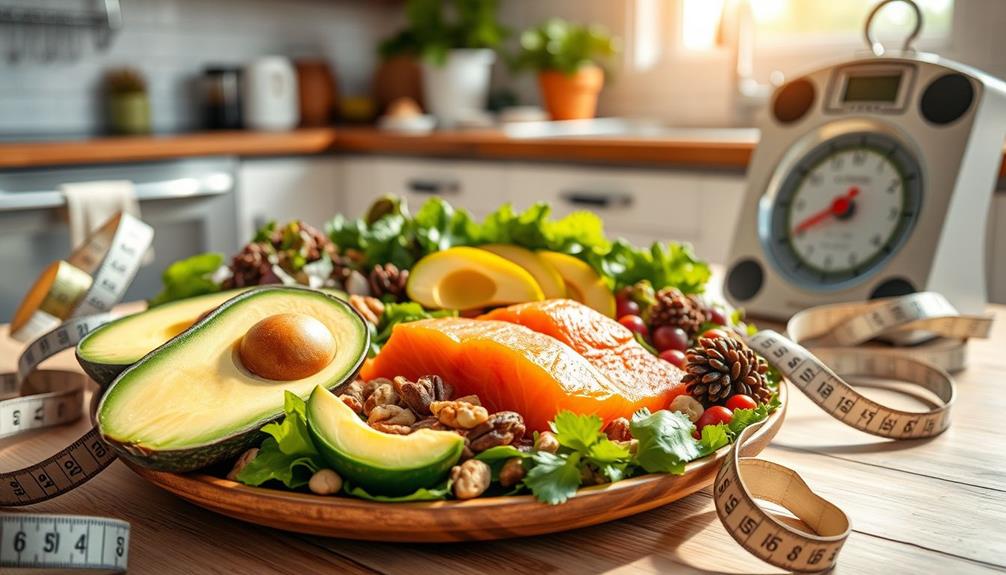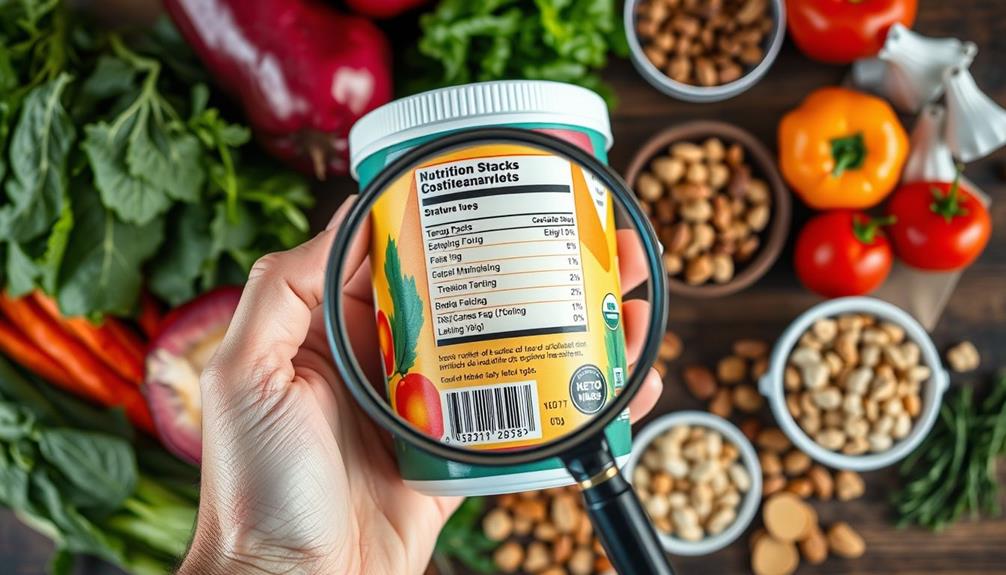To lose weight fast on the keto diet, you'll want to cut carbs to 20-50 grams daily and boost your fat intake. Aim for a macronutrient ratio of about 70-90% fats and 15-30% proteins. Focus on whole, nutrient-dense foods like avocados, nuts, and non-starchy vegetables while maintaining portion control to avoid excess calories. Staying hydrated, managing stress, and getting enough sleep also play an essential role. Don't forget to track your progress and adjust as needed. Get ready to uncover more tips that can keep you on track and boost your results!
Key Takeaways
- Reduce daily carbohydrate intake to 20-50 grams to induce and maintain ketosis effectively for rapid weight loss.
- Focus on whole, nutrient-dense foods, prioritizing healthy fats and non-starchy vegetables to enhance nutritional quality.
- Implement structured meal planning to control portion sizes and maintain proper macronutrient ratios (70-90% fats, 15-30% protein).
- Stay hydrated and replenish electrolytes to mitigate keto flu symptoms and support overall well-being during the transition.
- Regularly track your weight, body measurements, and macronutrient intake to monitor progress and stay motivated.
Key Principles of the Keto Diet

Understanding the key principles of the keto diet can set you on the path to successful weight loss. The ketogenic diet emphasizes drastically reducing your carbohydrate intake, typically to 20-50 grams per day. This reduction helps you enter ketosis, where your body shifts from burning glucose to burning fat for energy.
To achieve this, aim for macronutrient ratios where about 70-90% of your total daily calories come from healthy fats, with moderate protein intake at 15-30%. Additionally, incorporating antioxidant-rich foods, such as those found in celery juice, can support overall health during your weight loss journey.
It's vital to monitor your calorie intake and guarantee you're in a calorie deficit to enhance weight loss. While low-carb foods are essential, remember that not all keto-friendly foods are created equal. Whole, nutrient-dense options should be prioritized over processed ones to maximize health benefits and prevent excessive calorie intake.
A well-structured meal plan can help you maintain these macronutrient ratios, ensuring you stay in ketosis.
Nutritional Quality for Weight Loss

The quality of the foods you choose plays a significant role in your weight loss journey on the keto diet. Focusing on whole, nutrient-dense foods is essential, as processed keto-friendly options can sabotage your progress.
Incorporating healthy fats can also have important benefits, enhancing your overall well-being. To achieve effective weight loss, keep these three points in mind:
- Prioritize Healthy Fats: Aim for fats from sources like olive oil, avocados, and nuts. These enhance nutritional quality while keeping you satisfied.
- Incorporate Non-Starchy Vegetables: Adding these to your meals boosts fiber and nutrient intake, aiding digestion and helping you stay within your carb limits.
- Practice Portion Control: Even healthy fats can be high in calories. Monitor your portions to avoid exceeding your daily caloric goals and maintain a calorie deficit.
Tracking your macronutrient ratios—typically 5% carbs, 55-60% fats, and 30-35% proteins—is crucial for effective weight management.
Lifestyle Factors Impacting Success

Success on the keto diet isn't just about what you eat; it's also influenced by various lifestyle factors. To enhance your weight loss journey, consider the following elements:
| Lifestyle Factor | Impact on Weight Loss | Tips for Improvement |
|---|---|---|
| Stress Management | High cortisol can lead to fat storage. | Practice mindfulness and relaxation techniques. |
| Adequate Rest | Lack of sleep disrupts hunger hormones. | Aim for 7-9 hours of quality sleep. |
| Physical Activity | Boosts metabolism and aids fat loss. | Include both strength training and cardio. |
| Healthy Snacking | Helps prevent hunger but watch calorie intake. | Choose low-calorie, keto-friendly snacks. |
| Addressing Health Issues | Underlying conditions can hinder progress. | Consult a healthcare professional for guidance. |
Common Challenges and Solutions

Facing challenges is a natural part of any weight loss journey, and the keto diet is no exception. As you begin this lifestyle, you might encounter a few common hurdles. It's important to remember that incorporating mindfulness practices can help reduce emotional eating during this shift.
Additionally, focusing on a balanced diet rich in low-carb vegetables is essential for maintaining overall health and supporting your weight loss goals, as outlined in effective strategies for weight loss.
Here are some solutions to help you stay on track:
- Keto Flu: If you experience symptoms like fatigue or irritability, focus on hydration and increase your electrolyte intake. This can greatly alleviate discomfort during the initial shift.
- Carbohydrate Limit: Sticking to a strict carbohydrate limit of 20-50 grams daily can be tough. Utilize meal planning and tracking apps to keep your carb intake within target levels and avoid hidden carbs found in processed foods.
- Portion Control: Overindulging in keto-friendly foods like nuts and dairy can lead to exceeding calorie limits. Practice portion control to guarantee effective weight loss and make better choices when socializing.
Bring keto-friendly snacks or choose restaurants with low-carb options to stay compliant with your diet.
Tracking Progress Effectively

Tracking your progress on the keto diet is essential for staying motivated and making necessary adjustments. By consistently monitoring your weight changes and body measurements, you can better understand your journey toward fat loss. Aim for a sustainable loss of 1-3 pounds per week, and don't forget to track your macronutrient intake, particularly carbohydrates, to guarantee you're maintaining ketosis.
Here's a simple way to track your progress:
| Week | Ketone Levels | Body Measurements (Waist) |
|---|---|---|
| Week 1 | 1.5 mmol/L | 32 inches |
| Week 2 | 2.0 mmol/L | 31.5 inches |
| Week 3 | 1.8 mmol/L | 31 inches |
| Week 4 | 2.5 mmol/L | 30.5 inches |
| Week 5 | 2.2 mmol/L | 30 inches |
Using tools like food diaries or apps can help in accurately logging your daily macronutrient intake. Set specific short-term goals, like tracking weekly carb intake or non-starchy vegetable servings, to enhance your adherence to the keto diet. Celebrate your progress, and adjust your plan as needed!
Frequently Asked Questions
How Can I Speed up Weight Loss on Keto?
To speed up weight loss, focus on reducing your carb intake to 20-50 grams daily, incorporate intermittent fasting, engage in high-intensity workouts, monitor your calories, and stay hydrated with electrolytes to support your metabolism.
How Much Weight Can You Lose in a Week on Keto?
Imagine shedding your winter coat; on keto, you might lose 1 to 10+ pounds in the first week. This initial drop, fueled by water loss, sets the stage for more gradual fat loss ahead.
How Fast to Lose 20 Pounds on Keto?
To lose 20 pounds on keto, aim for a steady pace of 1-3 pounds per week. Stay consistent with your carb intake, track your calories, and incorporate exercise to boost your results effectively.
Can You Lose 10 Pounds in 5 Days on Keto?
Yes, you can lose 10 pounds in 5 days on keto, primarily due to water weight. However, for sustainable results, aim for a gradual weight loss of 1-3 pounds per week to maintain your health.
Conclusion
As you initiate your keto journey, remember that every choice counts. You're not just shedding pounds; you're transforming your lifestyle. But beware—temptations lurk around every corner, ready to sabotage your progress. Stay vigilant, keep your focus sharp, and celebrate those small victories. What if I told you that your dream body is closer than you think? Keep pushing forward, and soon enough, you'll reveal the incredible results waiting just beneath the surface.









